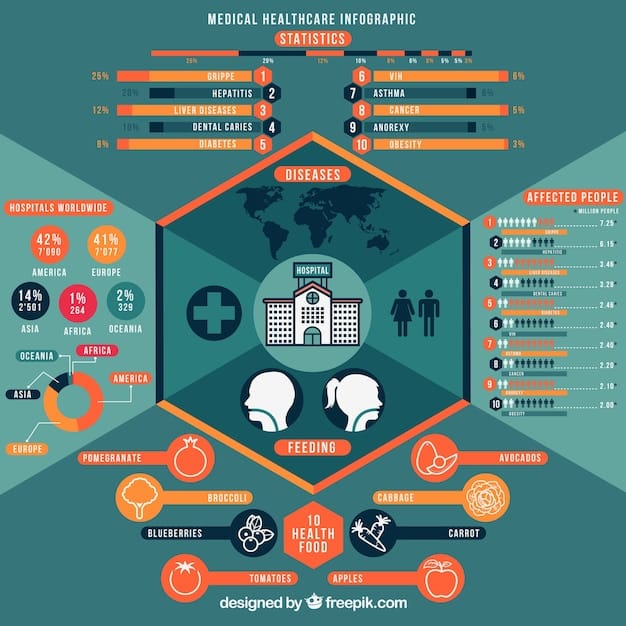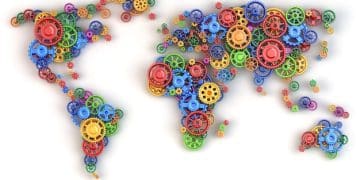How Updated IHRs Affect US Pandemic Preparedness

The updated International Health Regulations (IHRs) are poised to significantly alter the landscape of US pandemic preparedness by enhancing global surveillance, data sharing, and response coordination, necessitating domestic policy adjustments to align with international mandates and improve real-time threat assessment.
The global health landscape is in constant flux, demanding adaptive strategies for pandemic preparedness. A key development on this front involves the evolving International Health Regulations (IHR), a legally binding instrument of international law overseen by the World Health Organization (WHO). Understanding how updated International Health Regulations affect US pandemic preparedness is crucial for effective public health, national security, and economic stability.
understanding the international health regulations (IHR)
The International Health Regulations (IHR) serve as the cornerstone of global health security, providing a framework for countries to prevent, detect, assess, and respond to public health events that could cross borders. First adopted in their current form in 2005, the IHR are more than just guidelines; they are a legally binding agreement for 196 State Parties, including all 194 WHO Member States.
Their primary goal is to maximize protection against the international spread of diseases with minimum interference to world traffic and trade. This balance is delicate, aiming to safeguard public health while preventing unnecessary economic disruption.
evolution and purpose of the IHR
Since their inception, the IHR have undergone several revisions, reflecting lessons learned from past epidemics and pandemics. The 2005 version, in particular, was a significant leap forward, moving from a narrow focus on specific diseases to an all-hazards approach. This means that any public health event with potential for international spread can trigger IHR provisions, whether it’s an infectious disease, a chemical spill, or a radiological emergency.
The purpose is multifaceted:
- Early warning: To ensure that countries report potential public health emergencies of international concern (PHEICs) in a timely manner.
- Rapid response: To facilitate coordinated international responses, including technical assistance and resource mobilization.
- Capacity building: To obligate countries to develop core capacities for surveillance, laboratory diagnosis, and rapid response at national and local levels.
The framework also encourages collaboration and transparency, aiming to build trust among nations in sharing sensitive health information. This collaborative spirit is essential, as pathogens do not respect borders, making isolated national responses inherently limited.
The IHR establish clear criteria for determining what constitutes a PHEIC, enabling a standardized approach to threat assessment. This includes factors such as the seriousness of the public health impact, the unusual or unexpected nature of the event, the risk of international spread, and the risk of international travel or trade restrictions. These clear definitions help in distinguishing minor outbreaks from those requiring immediate global attention.
Despite their critical importance, the IHR faced significant challenges during the COVID-19 pandemic, sparking discussions about their effectiveness and the need for amendments to address identified gaps. The pandemic exposed vulnerabilities in global health governance, including delays in reporting, inadequate information sharing, and insufficient adherence to recommended public health measures. These shortcomings underscored the urgency for a more robust and responsive regulatory framework.
key proposed updates to the international health regulations
Amidst the profound lessons of the COVID-19 pandemic, calls for strengthening global health security mechanisms have intensified. This has led to ongoing negotiations for significant amendments to the International Health Regulations (IHR). These proposed updates aim to address critical shortcomings identified during the recent global health crisis, making the IHR more responsive, equitable, and effective in preventing and managing future pandemics.
The proposed changes encompass several key areas:
- Enhanced Surveillance and Early Warning: Proposals include stricter obligations for State Parties to report potential Public Health Emergencies of International Concern (PHEICs) more rapidly and transparently. This involves not only formal notification but also continuous sharing of real-time data, including genomic sequencing data, to enable quicker risk assessment.
- Equity and Resource Allocation: A major focus is on improving equity in access to health products, including vaccines, therapeutics, and diagnostics. The amendments propose mechanisms for faster and more equitable distribution, particularly to low-income countries, to prevent a repeat of the disparities observed during COVID-19. This includes potential frameworks for sharing intellectual property or facilitating technology transfer.
- Strengthened Compliance and Enforcement: Discussions are underway to introduce clearer mechanisms for monitoring State Parties’ compliance with IHR obligations and for providing support to those struggling to meet core capacities. While not aiming for punitive measures, the goal is to foster accountability and collaborative improvement.
- Increased WHO Authority and Funding: Some proposals suggest granting the WHO more direct authority to verify information about outbreaks, perhaps through independent missions, and to ensure predictable, sustainable funding for its emergency response functions. This would strengthen the organization’s capacity to lead and coordinate global responses.
These proposed updates are not merely technical adjustments; they represent a fundamental rethinking of how nations collectively manage global health threats. They recognize that a chain is only as strong as its weakest link, reinforcing the idea that robust preparedness in one country contributes to the security of all.
The negotiations are complex, reflecting diverse national interests and capabilities, but the shared experience of the pandemic provides a powerful impetus for progress. The amendments seek to institutionalize lessons learned, moving towards a more proactive rather than reactive global health security architecture.
Beyond these broad categories, specific amendments address issues like cross-border travel measures, public health corridors, and the management of “infodemics” – the spread of misinformation during public health crises. The aim is to create a more resilient system capable of adapting to new and unforeseen health challenges.

impact on US pandemic preparedness infrastructure
The United States, with its vast resources and scientific expertise, plays a pivotal role in global health security. The proposed updates to the International Health Regulations (IHR) will undoubtedly have far-reaching implications for the US pandemic preparedness infrastructure, necessitating adjustments across various levels of government and sectors.
One of the most immediate impacts will be the requirement for enhanced domestic surveillance and reporting systems. The updated IHR are expected to demand more granular and timely data sharing with the WHO, which means US agencies at federal, state, and local levels – such as the Centers for Disease Control and Prevention (CDC), state health departments, and local public health units – will need to streamline their data collection, analysis, and reporting protocols. This could involve investments in new technologies for real-time epidemiological tracking, laboratory diagnostics, and genomic surveillance capabilities, ensuring faster detection and characterization of novel pathogens.
Furthermore, the emphasis on equitable access to medical countermeasures under the updated IHR could influence US domestic production and distribution strategies. While the US prioritizes its own population, there may be increased pressure or international expectations for the US to contribute more directly to global supply chains, particularly during a PHEIC. This might involve pre-purchase agreements, technology transfer initiatives, or greater involvement in global vaccine and therapeutic manufacturing partnerships. It could also lead to a reassessment of existing national stockpiles and their readiness for both domestic and potential international contributions.
federal and state coordination
The updated IHR will likely underscore the importance of seamless coordination between federal agencies and state and local health authorities. Compliance with international obligations often translates into domestic policy changes. This could mean:
- Standardized Response Protocols: Developing nationally consistent frameworks for travel restrictions, quarantine measures, and public information campaigns that align with international guidelines.
- Capacity Building at Local Levels: Boosting funding and technical assistance for state and local health departments to meet IHR core capacities, especially in areas like rapid response teams, laboratory testing, and risk communication.
- Interagency Collaboration: Enhancing coordination among health, defense, diplomatic, and trade agencies to ensure a unified approach to global health events that considers national security and economic interests alongside public health.
The potential for increased WHO authority, even in a supportive role, might prompt discussions within the US about sovereignty and the extent to which international bodies can influence domestic public health decisions. However, the prevailing view is that robust international cooperation ultimately serves US national interests by containing outbreaks before they become pandemics.
In essence, the updated IHR will serve as a catalyst for continuous improvement and integration within the US pandemic preparedness system, pushing it towards greater transparency, equity, and global interconnectedness. It is an opportunity to fortify the nation’s defenses against future health crises by leveraging international collaboration and shared responsibility.
The US will need to review its legislative and regulatory frameworks to ensure alignment with the new IHR provisions. This may include amending existing laws or introducing new ones to empower health authorities with the necessary tools for rapid response and data exchange. Training and education programs for public health professionals will also need to be updated to reflect the evolving international standards and expectations. This adaptation is not merely about compliance, but about enhancing the effectiveness and resilience of the US health security apparatus.
opportunities and challenges for the US
The impending updates to the International Health Regulations (IHR) present both significant opportunities and complex challenges for the United States. Navigating these will require strategic foresight, diplomatic acumen, and robust domestic policy adjustments.
opportunities for strengthened security
The primary opportunity lies in strengthening US national health security through enhanced global cooperation. A more robust IHR framework means that other nations are also obligated to improve their surveillance and response capabilities, thereby reducing the likelihood of outbreaks escalating into pandemics that threaten the US. Specific opportunities include:
- Early Warning and Data Sharing: Improved international reporting mechanisms can provide the US with earlier warnings of emerging threats, allowing more time for effective border controls, vaccine development, and domestic preparedness measures. Access to real-time genomic data, for instance, is invaluable for understanding pathogen evolution and developing targeted countermeasures.
- Reduced Economic Disruption: By fostering more coordinated and effective international responses, the updated IHR can help mitigate the severe economic disruptions caused by pandemics. Preventing widespread illness and trade restrictions protects US businesses, global supply chains, and economic stability.
- Leveraging Global Expertise: Participation in a more stringent IHR framework means the US can benefit from shared best practices, research findings, and technical assistance from around the world, enhancing its own public health strategies.
- Diplomatic Influence: By actively engaging in and adhering to the updated IHR, the US can reinforce its leadership position in global health, fostering international goodwill and strengthening its diplomatic influence on other critical issues.
Collaboration within a strengthened IHR framework can also lead to more efficient resource allocation. Rather than each country independently developing and deploying every tool needed for a pandemic, shared platforms and coordinated efforts can streamline the process, resulting in better outcomes with potentially lower overall costs.
challenges and considerations
Despite the opportunities, several significant challenges exist for the US:
- Sovereignty Concerns: Some concerns may arise regarding how enhanced WHO authority or stricter reporting obligations might impinge on national sovereignty. Striking the right balance between international cooperation and domestic autonomy will be a subject of ongoing debate.
- Resource Allocation and Funding: Meeting new IHR core capacities and contributing to global equity initiatives will likely require increased funding and resource allocation, both domestically and internationally. This could present budgetary challenges and require careful prioritization.
- Data Security and Privacy: Increased data sharing, while beneficial for public health, raises questions about data security, privacy, and intellectual property protection, particularly concerning sensitive health information and genomic data. Robust legal frameworks and technological safeguards will be essential.
- Compliance and Enforcement: Ensuring that all State Parties genuinely comply with the updated IHR, especially those with limited resources or political will, remains a formidable challenge. The IHR are binding, but enforcement mechanisms are primarily diplomatic and technical, not punitive.
- Political Will and Public Trust: Sustaining the political will to invest in long-term preparedness, both domestically and internationally, can be difficult once a crisis subsides. Furthermore, maintaining public trust in global health institutions and the information they disseminate is crucial in combating misinformation.
The US must carefully consider these challenges while actively shaping the IHR amendments to ensure they are both effective and equitable. This includes advocating for frameworks that are flexible enough to accommodate diverse national contexts while upholding universal standards for public health protection.
strengthening cross-border collaboration and information sharing
A central tenet of the updated International Health Regulations (IHR) is the imperative for intensified cross-border collaboration and transparent information sharing. The COVID-19 pandemic unequivocally demonstrated that isolated national responses are ineffective against globally mobile pathogens. For the US, embracing and leading this principle is paramount for enhancing its own pandemic preparedness.
The proposed IHR amendments are expected to codify stronger obligations for State Parties to share information about public health events in real-time. This extends beyond initial notifications to include continuous updates on epidemiological data, genomic sequences of pathogens, clinical outcomes, and the effectiveness of countermeasures. For the US, this means:
- Enhanced International Partnerships: Deepening partnerships with countries, particularly those in regions prone to emerging infectious diseases. This involves not only formal governmental agreements but also fostering direct relationships between public health agencies, research institutions, and laboratories worldwide.
- Standardized Data Platforms: Advocating for and participating in the development of standardized, interoperable data platforms for global health surveillance. This would streamline the sharing of critical information, allowing for faster analysis and coordinated decision-making.
- Joint Training and Exercises: Engaging in more frequent and comprehensive joint exercises with international partners to test surge capacities, communication protocols, and cross-border response scenarios. This builds trust and operational readiness before a crisis hits.
- Addressing Information Gaps: Collaborating with WHO and other international bodies to develop mechanisms for verifying information and addressing potential gaps or delays in reporting from all State Parties, thereby building a more complete global picture of emerging threats.
The emphasis on transparency extends to sensitive areas like data related to vaccine effectiveness and the characteristics of new variants. The US, with its advanced scientific capabilities, can play a leading role in sharing such insights, while simultaneously benefiting from data contributed by other nations. This reciprocal flow of information is essential for developing a comprehensive global threat assessment.
Beyond formal government-to-government channels, strengthening collaboration means empowering public health professionals to build informal networks, sharing best practices, and collectively problem-solving. These professional connections often prove invaluable during crises, bridging diplomatic gaps and facilitating rapid responses.
However, challenges remain. Issues of data ownership, intellectual property rights, and commercial interests can complicate information sharing. The US must champion frameworks that balance these concerns with the overarching imperative of public health security, promoting a culture of openness and shared responsibility. Additionally, combating misinformation and disinformation that can erode public trust and undermine collaborative efforts will be a continuous challenge that requires international cooperation on communication strategies.
addressing equity and resource distribution challenges
A significant lesson from the COVID-19 pandemic was the profound global inequity in access to essential medical countermeasures, particularly vaccines. The proposed updates to the International Health Regulations (IHR) are poised to address this imbalance directly, aiming to embed principles of equity and fair resource distribution more deeply within the global health security framework. For the US, this presents both a moral imperative and a strategic challenge.
equity in access and distribution
The amendments are expected to push for mechanisms that ensure equitable access to health products during a Public Health Emergency of International Concern (PHEIC). This could involve:
- Fair Allocation Frameworks: Developing pre-agreed frameworks for the allocation of limited medical supplies (vaccines, therapeutics, diagnostics) based on public health need rather than merely economic leverage.
- Technology Transfer and Manufacturing Capacity: Encouraging or mandating the sharing of intellectual property, technical know-how, and manufacturing capabilities to increase localized production of essential health products, especially in low and middle-income countries (LMICs). This reduces reliance on a few concentrated manufacturing hubs and builds global resilience.
- Financial Mechanisms: Establishing or strengthening global financing mechanisms to support the procurement and distribution of medical countermeasures in LMICs, ensuring that affordability is not a barrier to access.
For the US, a country with significant pharmaceutical and biotechnological capabilities, this means re-evaluating its role in global health equity. While domestic needs will always be a priority, there’s a growing recognition that global health security is intrinsically linked to national security. An uncontrolled outbreak anywhere poses a risk everywhere.
The challenge for the US will be to balance domestic priorities with global responsibilities, potentially requiring adjustments to existing intellectual property laws, licensing agreements, and national manufacturing strategies. It also involves sustained political will to contribute financially and technically to global initiatives aimed at strengthening health systems in vulnerable nations. This is not charity but a strategic investment in collective security.
Furthermore, the US will need to consider how to optimize its own procurement and deployment of medical countermeasures during a PHEIC, ensuring that its systems are agile enough to meet both domestic demands and contribute to global efforts when appropriate. This dual responsibility requires careful planning, transparent communication, and robust public-private partnerships.
Addressing these equity challenges is critical for fostering global trust and solidarity, which are indispensable for effective pandemic response. A world where some nations are left behind in the fight against a common pathogen is a world more vulnerable to future crises.
The concept of “vaccine nationalism,” observed during the early phases of the COVID-19 pandemic, demonstrated the pitfalls of a fragmented approach. The updated IHR seeks to prevent repetitions of such scenarios by promoting shared responsibility and equitable outcomes. This shift requires a deep commitment from high-income countries, including the US, to actively participate in and uphold the principles of global solidarity, recognizing that self-interest and collaboration align in the face of cross-border health threats.
legal and policy implications for the US government
The updated International Health Regulations (IHR) represent a significant legal and policy undertaking for the US government. As a State Party to the IHR, the US is legally bound to implement its provisions, meaning that changes at the international level will necessitate adjustments within the domestic legal and policy landscape. This process is complex, involving multiple layers of government and various stakeholders.
navigating domestic implementation
The primary implication is the need to align existing US laws, regulations, and policies with the newIHR obligations. This could involve:
- Legislative Review: Congress may need to review and potentially amend existing statutes, such as those governing public health emergency powers, data sharing, and international cooperation. For instance, if the IHR introduce more direct roles for international verification missions, corresponding domestic laws might be needed to facilitate such activities.
- Regulatory Adjustments: Federal agencies like the Department of Health and Human Services (HHS), the Centers for Disease Control and Prevention (CDC), and the Department of State will likely need to update their regulations and guidelines. This includes rules related to surveillance, border health measures, and information exchange with international bodies.
- Interagency Coordination: The IHR’s broad scope—covering health, trade, travel, and security—demands enhanced interagency coordination. The National Security Council (NSC) will likely play a central role in orchestrating a unified federal approach, ensuring that foreign policy, national security, and public health objectives are harmonized.
Furthermore, the US legal system operates under a principle of federalism, where states and sometimes local governments retain significant authority over public health matters. Implementing international health regulations often requires complex coordination between federal mandates and state capacities. This means that uniformity in public health responses across states might need to be encouraged through federal funding, technical assistance, and standardized guidelines to meet IHR requirements effectively.
Another crucial legal aspect is the balance between public health measures and individual liberties. Any policy changes stemming from the IHR, such as expanded contact tracing, mandatory health declarations for travelers, or vaccine distribution frameworks, must be carefully vetted against US constitutional principles of privacy and civil rights. Transparency in policy-making and public engagement will be vital to maintain societal trust and compliance.
From a policy perspective, the US will need to strategically engage in the ongoing IHR amendment negotiations. This involves advocating for provisions that are both effective in enhancing global health security and feasible for domestic implementation. The US has a strong interest in ensuring that the final IHR text is clear, implementable, and respects national sovereignty while promoting collective action.
Ultimately, the legal and policy implications are about building a more resilient, adaptive, and globally integrated public health system that can protect the US population from cross-border health threats. It requires a proactive approach to legislative and regulatory reform, coupled with sustained investment in public health infrastructure and workforce development.
The discussions surrounding whether specific IHR provisions could be interpreted as impinging on US sovereignty will continue, but the overriding consensus is that a stronger global framework ultimately serves US national security by containing threats at their source. This understanding drives the ongoing engagement and facilitates the domestic policy adjustments needed to align with a modernized global health instrument.

the road ahead: ensuring robust pandemic readiness
As the international community moves towards finalizing the updated International Health Regulations (IHR), the road ahead for the United States in ensuring robust pandemic readiness is clear, complex, and requires sustained commitment. The IHR revisions are not a panacea but a critical framework that demands proactive domestic engagement and strategic international leadership.
One of the foremost priorities for the US will be to continue investing in and strengthening its core public health capacities at all levels—federal, state, and local. This includes enhancing epidemiological surveillance, laboratory networks, public health workforce development, and robust data infrastructure. The capacity to rapidly detect, diagnose, and report outbreaks domestically is foundational to meeting IHR obligations and protecting the nation from emerging threats. This also involves continuous training and equipping of frontline public health workers, who are the first line of defense.
Furthermore, the US must reinforce its commitment to research and development of medical countermeasures. This includes diversified vaccine platforms, broad-spectrum antivirals, and rapid diagnostic tests. Lessons from COVID-19 underscored the importance of speed and scale in developing these tools, and sustained funding for both basic science and translational research is paramount. Partnering with the private sector and fostering innovation will also be crucial.
Active and constructive participation in global health governance, particularly within the WHO, is another vital element. The US can shape the implementation of the updated IHR by providing technical expertise, contributing financial resources, and advocating for effective, equitable, and evidence-based global health policies. Its leadership is indispensable in fostering a climate of trust and transparency among nations, which is essential for effective global health security.
Finally, maintaining public trust and engaging in transparent risk communication will be central to success. During any public health crisis, the public needs clear, consistent, and accurate information to make informed decisions and comply with public health measures. Building this trust requires open dialogue, combating misinformation, and demonstrating accountability from public health authorities.
The updated IHR offers a renewed opportunity to fortify global health defenses through shared responsibility and enhanced cooperation. For the US, leveraging this framework means not just preparing for the next pandemic, but actively shaping a more secure and resilient future for global health. This comprehensive approach, combining domestic strength with international collaboration, is the bedrock of enduring pandemic readiness.
The US must also prepare for novel challenges not explicitly defined by current regulations, such as pandemics driven by antimicrobial resistance or dual-use research concerns. This requires flexibility in its preparedness plans and a willingness to adapt swiftly to unforeseen circumstances, ensuring that the updated IHR serves as a dynamic, rather than static, instrument for global health security.
| Key Aspect | Brief Description |
|---|---|
| 📊 Enhanced Data Sharing | Stricter obligations for timely and transparent reporting of health data, including genomic sequences. |
| ⚖️ Equity & Access | Mechanisms for fair allocation of health products and technology transfer. |
| 🏛️ Legal & Policy Shifts | Requires alignment of US domestic laws and regulations with new global health mandates. |
| 🤝 Cross-Border Collaboration | Demands deeper international partnerships and joint training to improve response readiness. |
frequently asked questions on IHR and US preparedness
The IHR are a legally binding international law instrument, adopted by 196 countries, including the US, to help the global community prevent and respond to public health risks that could cross borders. They provide a framework for early detection, rapid assessment, and coordinated response to health emergencies of international concern.
The updated IHRs are expected to require more rapid and transparent data sharing, potentially pushing the US to enhance its domestic surveillance systems for real-time epidemiological and genomic data. This will necessitate improved coordination between federal, state, and local health agencies to meet international reporting obligations effectively.
Yes, significant IHR updates could require the US to review and potentially amend existing federal statutes and agency regulations to ensure alignment. This involves laws related to public health emergency powers, international data sharing, and coordination between different levels of government to facilitate compliance.
A key focus of the updates is on promoting equitable access to health products. This may involve new frameworks for fair allocation of supplies, encouraging technology transfer for manufacturing in more countries, and establishing financial mechanisms to support procurement in low-income nations during pandemics.
One primary challenge for the US is balancing national sovereignty concerns with enhanced international obligations. This includes navigating data privacy, intellectual property rights, and resource allocation decisions while ensuring robust domestic health security and maintaining public trust in global health initiatives.
conclusion
The updated International Health Regulations are set to reshape global health governance, with profound implications for how the US prepares for and responds to future pandemics. By committing to enhanced surveillance, equitable resource distribution, and stronger cross-border collaboration, the US can fortify its own defenses while contributing to a more resilient global health architecture. This adaptive approach, grounded in lessons learned from past crises, is essential for navigating an interconnected world where health threats recognize no borders.





